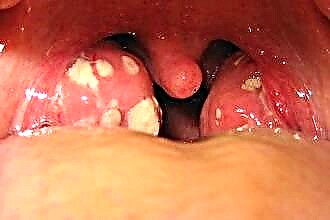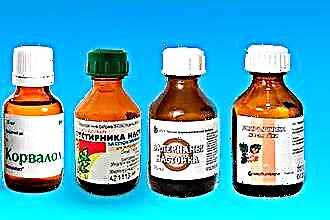Angina in children occurs 3 times more often than in an adult, which is associated with a low reactivity of the body. Many parents diagnose the disease by only two or three signs, the main of which is hyperemia, i.e. redness, throat.
 According to Dr. E.O. Komarovsky, it is extremely difficult to determine the type of ENT disease without special education and appropriate tests.
According to Dr. E.O. Komarovsky, it is extremely difficult to determine the type of ENT disease without special education and appropriate tests.
In practice, more than 95% of people do not have the necessary understanding of a disease such as tonsillitis (tonsillitis). Most parents are sure that "sore throat" and "sore throat" are in the same synonymous row, although this is a controversial issue. Swelling of the throat mucosa and redness may indicate the development of at least 10 infectious diseases, and about 50% of them have nothing to do with angina.
About the disease
Evgeny Olegovich Komarovsky is a practicing physician of the highest category, who has written several medical works and popular science articles on the principles of diagnosing and treating diseases in children. The specialist is sure that it is possible to protect a child from severe post-infectious complications only in case of timely treatment of an infectious disease.
Tonsillitis is a severe ENT disease characterized by damage to the tonsils and the mucous membrane of the throat. As a rule, bacteria are the causative agents of infection, but in about 10% of cases, viral sore throat is diagnosed in children. Treatment of bacterial and viral inflammation in the oropharynx is accompanied by the intake of various types of medications.
Bacterial forms of tonsillitis can be eliminated with antibiotics, but the viral flora is not sensitive to the effects of drugs of this group. That is why the incorrect definition of the type of ENT disease is one of the key reasons for ineffective therapy and the development of post-infectious complications. In children, treatment of pathology should be started when the first symptoms of inflammation are detected. A quick response to the problem prevents the spread of inflammation and damage to neighboring organs, in particular the paranasal sinuses and middle ear.
Symptomatic picture
Often the child's complaints about discomfort in the throat and malaise have nothing to do with tonsillitis. Hyperemia and swelling of the mucous membrane may indicate the development of a common cold caused by viruses. What is the difference between viral and bacterial disease and can they be distinguished by their external manifestations?
According to Dr. Komarovsky, bacterial inflammation is more often triggered by a streptococcal infection, namely beta-hemolytic streptococcus.
 In the case of penetration into the nasopharyngeal mucosa, it begins to actively multiply, causing intoxication and inflammatory processes:
In the case of penetration into the nasopharyngeal mucosa, it begins to actively multiply, causing intoxication and inflammatory processes:
- hyperemia of the throat;
- swelling of the oropharynx;
- painful sensations when swallowing;
- strong rise in temperature;
- difficulty breathing through the mouth;
- swollen lymph nodes in the neck; drowsiness and lack of appetite.
In about 20% of young children, bacterial sore throat is accompanied by intestinal syndrome, i.e. abdominal pain, flatulence and diarrhea.
Local symptoms may also indicate the development of tonsillitis, provoked by bacteria. The presence of purulent plugs and veins on the palatine tonsils indicates the accumulation of neutrophils and pathogenic bacterial cells in the foci of inflammation. It should be noted that purulent tonsillitis, especially streptococcal, can lead to disastrous consequences. Therefore, if you find characteristic symptoms, you should consult a pediatrician, and not self-medicate.
The clinical manifestations of viral tonsillitis have a number of characteristic differences that not only doctors, but also parents should be aware of. As a rule, ENT disease is provoked by viruses, in particular adenoviruses, herpes viruses, rhinoviruses, etc. Inflammation of the pharyngeal mucosa is most often secondary and occurs against the background of the development of acute respiratory viral infections, pharyngitis, rhinitis, laryngitis, etc.
Viral tonsillitis is accompanied by hyperemia of the oropharynx, but without a hint of purulent formations. The disease may be accompanied by nasal congestion, rhinitis, conjunctivitis, low temperature, etc.
Forms of the disease
The child's body is susceptible to infectious diseases, which is associated with the instability of the immune system and the practical absence of antibodies to most infectious agents. When the first symptoms of sore throat occur, complex medication should be started.
Komarovsky warns that the principles of therapy for different forms of tonsillitis can be very different, which is due not only to the nature of the pathogens, but also to the place of their localization.
In children under the age of 15, the following types of purulent inflammation of the oropharynx are most common:
 follicular tonsillitis - the formation of pinpoint purulent plugs in the follicles of the lymphadenoid tissue (palatine tonsils);
follicular tonsillitis - the formation of pinpoint purulent plugs in the follicles of the lymphadenoid tissue (palatine tonsils);- lacunar tonsillitis - the appearance of purulent "streaks" in the crypts or canals of the tonsils;
- phlegmonous tonsillitis - bacterial inflammation of the periaminal fiber.
Important! Treatment of phlegmonous inflammation occurs in stationary conditions, which is associated with the risk of severe edema of the tissues of the pharynx and blockage of the airway.
Bacterial sore throat is harder for children than viral inflammation. This is partly due to severe intoxication of the body, which is characterized by a sharp rise in temperature to febrile levels. But if a viral pathology is not treated in time, a bacterial infection can subsequently join it, which will greatly complicate the course of the disease.
Therapeutic measures
How to treat angina in children? Komarovsky is convinced that therapy for ENT disease should be aimed not only at destroying the causative agent of the infection, but also at relieving symptoms. An integrated approach ensures the rapid elimination of pathogenic flora and local manifestations of pathology, which has a beneficial effect on the child's well-being, appetite, chances of recovery without serious consequences, etc.
Antibiotics or antiviral agents should be used as drugs of etiotropic action. It is possible to stop general and local manifestations of the disease with the help of symptomatic medicines. The classic treatment regimen usually includes:
- antibiotics;
- antipyretic drugs;
- oropharyngeal rinse solutions;
- aerosols for irrigation of the throat mucosa;
- antiviral medicines;
- tablets and lozenges for sucking.
Due to the strong enlargement of the palatine tonsils, the child is not able to swallow solid food. To prevent injury to the mucous membrane, parents should take care of transferring the child to a "liquid" diet using mashed potatoes, cream soups, cereals, etc.
Antibiotics
 The causative agents of purulent sore throat can be gram-positive and gram-negative bacteria, some of which have the ability to counteract the components of medications. Therefore, both the diagnosis and treatment of ENT diseases should be carried out only by a competent specialist. The following types of antimicrobial drugs can be used to kill bacteria:
The causative agents of purulent sore throat can be gram-positive and gram-negative bacteria, some of which have the ability to counteract the components of medications. Therefore, both the diagnosis and treatment of ENT diseases should be carried out only by a competent specialist. The following types of antimicrobial drugs can be used to kill bacteria:
- penicillins - active against most gram-positive microorganisms;
- macrolides - destroy gram-positive bacteria and some types of intracellular parasites;
- cephalosporins - are resistant to bacteria that produce β-lactamase.
The minimum course of antibiotic therapy in children is 7 days.
Treatment begins with taking drugs of the penicillin series, but with the development of allergic reactions or the absence of the proper therapeutic effect, they are replaced with macrolides. Macrolides are among the most non-toxic antibiotics that have the ability to destroy not only bacteria, but also protozoa. If their use does not bring the desired results, cephalosporins, broad-spectrum antibiotics, are included in the treatment regimen. They destroy almost all existing bacterial strains, including those capable of producing β-lactamase and penicillinase.
Drug overview
The treatment regimen and drugs should be selected by a specialist in accordance with the patient's age, his tendency to allergies, the degree of development of inflammation and the type of infectious agent. As a rule, medications with a minimal spectrum of adverse reactions are used to treat the smallest patients. As anti-inflammatory drugs are used:
- Calpol;
- Nurofen;
- Ibuklin.
To stop viral inflammation, antiviral and immunostimulating drugs are used.
 To reduce the risk of irritation of the gastric mucosa, it is more advisable to purchase drugs in the form of rectal suppositories or syrups.
To reduce the risk of irritation of the gastric mucosa, it is more advisable to purchase drugs in the form of rectal suppositories or syrups.
The most effective are "Arbidol", "Anaferon", "Kipferol", etc. In turn, antibiotics such as Augmentin, Azithromycin, Amoxicillin and Cefazolin can be used to kill bacteria. To prevent the development of dysbiosis, in parallel with antibiotics, you need to take probiotics - "Bifiform" or "Linex".

 follicular tonsillitis - the formation of pinpoint purulent plugs in the follicles of the lymphadenoid tissue (palatine tonsils);
follicular tonsillitis - the formation of pinpoint purulent plugs in the follicles of the lymphadenoid tissue (palatine tonsils);

